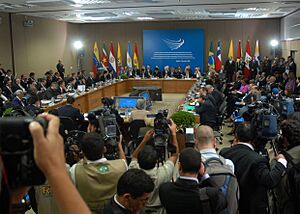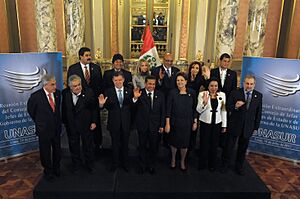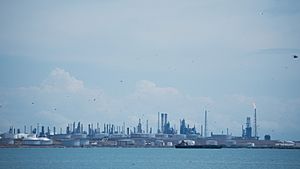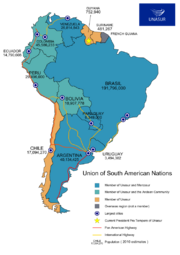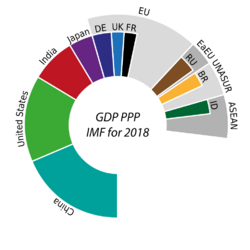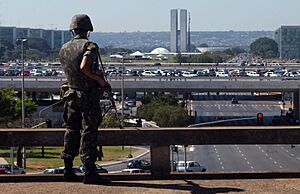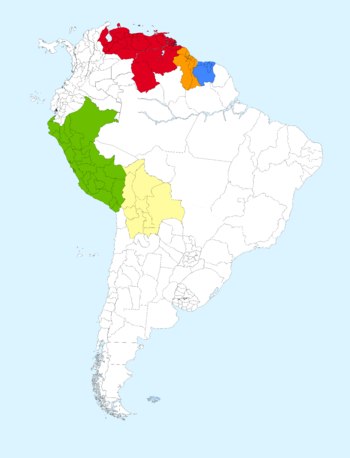Union of South American Nations facts for kids
Quick facts for kids
Union of South American Nations
|
|||||||
|---|---|---|---|---|---|---|---|
|
Motto: "Soy del Sur" (I am from the South)
|
|||||||
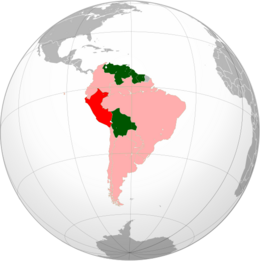
Member states Suspended member states Former member states
|
|||||||
| Administrative centers |
|
||||||
| Official languages |
|
||||||
| Demonym(s) | South American | ||||||
| Type | Continental union | ||||||
| Membership | |||||||
| Leaders | |||||||
|
• President
|
Vacant | ||||||
|
• Secretary General
|
Vacant | ||||||
| Legislature | South American Parliament | ||||||
| Establishment | Formation | ||||||
|
• Cusco Declaration
|
8 December 2004 | ||||||
|
• Constitutive Treaty
|
23 May 2008 | ||||||
|
• Treaty in force
|
11 March 2011 | ||||||
| Currency | |||||||
| Time zone | UTC−05 to −03 | ||||||
| Calling code | see list | ||||||
| Internet TLD | |||||||
|
Notes
: Membership suspended |
|||||||
The Union of South American Nations (UNASUR) is a group of countries in South America that work together. It is also known as the South American Union. This organization was created to help South American countries cooperate more closely. It aimed to reduce the influence of countries outside the region.
The main agreement, called the UNASUR Constitutive Treaty, was signed on May 23, 2008. This happened at a big meeting in Brasília, Brazil. The treaty officially made UNASUR a legal group on March 11, 2011. Its main office was planned for Quito, Ecuador.
In April 2018, several countries like Argentina, Brazil, and Chile paused their membership. Colombia left the group in August 2018. Ecuador and Uruguay also announced their withdrawal in 2019 and 2020. However, Brazil rejoined UNASUR on May 5, 2023. Argentina also rejoined in April 2023.
In January 2019, a new group called PROSUL/PROSUR was formed. This group aimed to create a new way for South American countries to work together.
Contents
What is UNASUR?
At a meeting in December 2004, leaders from 12 South American countries signed the Cusco Declaration. This paper announced the start of the South American Community. Panama and Mexico were there as observers.
An important rule for UNASUR was not to create many new offices at first. Instead, it planned to use existing groups that were already working together. This helped avoid too much paperwork and bureaucracy.
How UNASUR Started
South America has a long history of countries trying to work together. For centuries, Spain and Portugal ruled large parts of the continent. After these countries gained independence, many leaders wanted them to unite.
One famous leader, Simón Bolívar, dreamed of a big federation of new republics. In 1826, he called a meeting in Panama. This meeting aimed to form a group that could protect the new countries. However, the ideas from this meeting were not fully put into action.
By the 1990s, Brazil became a very strong country in South America. It started to promote the idea of a united South America. This idea became more popular in the 2000s.
Forming the Union
The idea of bringing together different groups in South America became official in May 2008. This happened at a meeting of leaders in Brasília.
The Cuzco Declaration in 2004 was a key step. It showed that leaders wanted to create a "South American Community of Nations." They even thought about having a shared passport and a single currency, like the European Union.
Uruguay was the ninth country to agree to the main treaty in December 2010. This meant enough countries had agreed for the treaty to become law. On March 11, 2011, UNASUR officially became a legal organization.
Choosing the Name
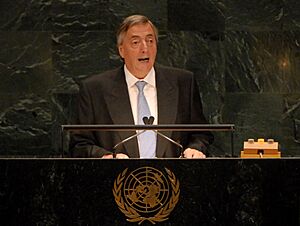
At first, the group was called the "South American Community of Nations." Some people suggested changing it to "South American Union." However, this was rejected because its short form, U.S.A., could be confused with the United States of America.
Finally, on April 16, 2007, the name was changed to Union of South American Nations. All member countries agreed to this new name.
Challenges and Changes
After January 2017, UNASUR faced challenges in choosing new leaders. This led to some disagreements among member countries.
In April 2018, six countries, including Argentina and Brazil, announced they would pause their membership for a year. They felt the organization was not working well. Some leaders said UNASUR was "not getting anywhere."
Countries Leaving and Rejoining
- Colombia: On August 28, 2018, Colombia announced it would leave UNASUR. However, in 2023, Colombia announced it would rejoin.
- Brazil: On March 7, 2019, Brazil announced its withdrawal. But after a new president was elected, Brazil rejoined on May 5, 2023.
- Ecuador: On March 13, 2019, Ecuador also announced its withdrawal. Ecuador's president asked for the UNASUR headquarters building in Quito to be returned.
- Argentina: On April 12, 2019, Argentina announced its withdrawal. However, Argentina rejoined UNASUR in April 2023.
- Uruguay: On March 11, 2020, Uruguay announced its withdrawal.
How UNASUR is Organized
The leaders of each member country used to meet once a year. This was the highest decision-making body. The first meeting was in Brasília in September 2005.
The foreign ministers of each country met every six months. They made plans and decisions for the group. The South American Parliament is planned to be in Cochabamba, Bolivia.
Secretary General

The Secretary General is the main representative of UNASUR. The office is in Quito, Ecuador. Néstor Kirchner of Argentina was the first Secretary General, starting in May 2010. After his death, María Emma Mejía Vélez was elected in March 2011. The most recent Secretary General was Ernesto Samper, whose term ended in January 2017. Since then, the position has been vacant.
| No. | Secretary General | Country | Beginning of the mandate | End of the mandate | ||
|---|---|---|---|---|---|---|
| 1 | Néstor Kirchner | 4 May 2010 | 27 October 2010 | |||
| — | Interim | |||||
| 2 | María Emma Mejía Vélez | 9 May 2011 | 11 June 2012 | |||
| 3 | Alí Rodríguez Araque | 11 June 2012 | 31 July 2014 | |||
| 4 | Ernesto Samper | 1 August 2014 | 31 January 2017 | |||
| — | Vacant; No successor approved. | |||||
Temporary Presidency
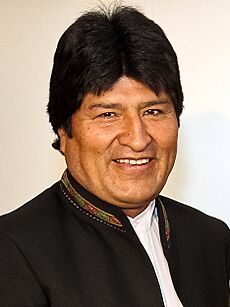
The temporary presidency of UNASUR rotates among member countries each year. This leader helps guide the union's work. The office is located in Quito, Ecuador.
| No. | President pro tempore | Country | Beginning of the Mandate | End of the Mandate |
|---|---|---|---|---|
| 1 | Michelle Bachelet | 23 May 2008 | 10 August 2009 | |
| 2 | Rafael Correa | 10 August 2009 | 26 November 2010 | |
| 3 | Bharrat Jagdeo | 26 November 2010 | 29 October 2011 | |
| 4 | Fernando Lugo | 29 October 2011 | 22 June 2012 | |
| 5 | Ollanta Humala | 22 June 2012 | 30 August 2013 | |
| 6 | Dési Bouterse | 30 August 2013 | 4 December 2014 | |
| 7 | José Mujica | 4 December 2014 | 1 March 2015 | |
| 8 | Tabaré Vázquez | 1 March 2015 | 17 April 2016 | |
| 9 | Nicolás Maduro | 17 April 2016 | 21 April 2017 | |
| 10 | Mauricio Macri | 21 April 2017 | 17 April 2018 | |
| 11 | Evo Morales | 17 April 2018 | 16 April 2019 |
Important Councils
UNASUR had several councils to help with different areas. These included:
- Council of South American Defense
- South American Council of Health
- South American Council of Economy and Finances
Council of Economy and Finance
This council was set up in August 2011. It aimed to strengthen trade between countries using their own currencies. This would reduce the need for US dollars. The council also looked at ways to support development banks.
Council of South American Defense
This council was approved in December 2008. It brings together defense ministers from member countries. Its goal is to create shared defense policies. It also promotes military cooperation and joint exercises.
South American Council of Health
This council was created in December 2008. It brings together health ministers to develop regional health programs. It aims to improve public health across South America. The council works to solve health challenges that affect multiple countries. It also promotes sharing knowledge and technology in health.
Meetings and Summits
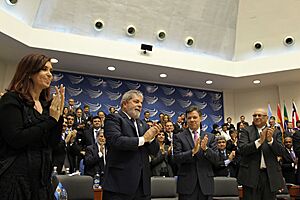
The first major UNASUR summit was in Brasília on May 23, 2008. Here, the main treaty was signed. Other important meetings were held to discuss various issues. For example, an emergency summit was held in September 2008 to support Bolivia during a political crisis.
| No. | Date | Country | Host | Host leader |
|---|---|---|---|---|
| 1st | 15 September 2008 | Santiago de Chile | Michelle Bachelet | |
| 2nd | 10 August 2009 | Quito | Rafael Correa | |
| 3rd | 28 August 2009 | Bariloche | Cristina Fernández de Kirchner | |
| 4th | 26 November 2010 | Georgetown | Bharrat Jagdeo | |
| 5th | 29 October 2011 | Asunción | Fernando Lugo | |
| 6th | 30 November 2012 | Lima | Ollanta Humala | |
| 7th | 30 August 2013 | Paramaribo | Dési Bouterse | |
| 8th | 4 December 2014 | Guayaquil | Rafael Correa |
- A special UNASUR/BRICS leaders summit was held in Fortaleza, Brazil, in July 2014.
- The 9th Summit, planned for April 23, 2016, in Quito, was canceled due to an earthquake in Ecuador.
People and Languages
At its largest, UNASUR included about 410 million people. South America has many different environments, from tropical forests to deserts. The population is a mix of people with European, African, and indigenous backgrounds. There are also many people of mixed heritage.
The main languages are Spanish and Portuguese. English and Dutch are also spoken in some countries. Many indigenous languages are also important, like Quechua, Aymara, and Guarani.
Religions in UNASUR Countries
Most people in South America are Christians, mainly Roman Catholics. There are also many Protestants and other Christian groups. Due to immigration, Suriname and Guyana have large Hindu and Muslim communities. Other religions, like Kardecist Spiritism, are also found.
| Countries | Christians | Roman Catholics | Other Christians | Other religions | No religion (atheists and agnostics) |
|---|---|---|---|---|---|
| 96% | 74% | 22% | 0% | 4% | |
| 57% | 7% | 50% | 40% | 3% | |
| 48% | 22% | 26% | 42% | 10% | |
| 88% | 71% | 17% | 4% | 8% |
Economy and Trade
The economy of UNASUR countries relies on mining, especially in the Amazon, and agriculture. Many countries also have industries. Venezuela is known for its large oil reserves. Bolivia has significant natural gas production.
Common Market Goals
One of UNASUR's goals was to create a common market. This meant removing taxes on goods traded between member countries. The plan was to remove taxes on most products by 2014 and on all products by 2019.
There were also plans to improve infrastructure, like building new highways. The Initiative for the Integration of the Regional Infrastructure of South America aimed to connect countries better. For example, the Pacific Highway, connecting Peru and Brazil, was completed in 2010.
Economic Development Efforts
In December 2007, the Bank of the South was officially launched. This bank aimed to fund projects that would help countries grow economically. It focused on improving local businesses and promoting scientific development. The bank's goal was to help South American countries integrate and share investments fairly.
Money and Currency
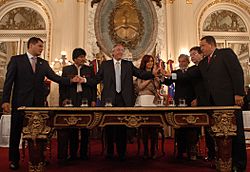
The Bank of the South was also meant to help with money policies. One big idea was to create a Single South American currency. Some leaders, like Peru's president Alan García, supported this idea. Bolivia's president Evo Morales even suggested naming the currency "Pacha," meaning "earth" in Quechua.
Defense and Security
The South American Defense Council (CDS) was proposed to improve regional security. It aimed to promote military cooperation among member countries. The goal was not to form a military alliance like NATO. Instead, it focused on working together, building trust, and sharing defense industry knowledge. Colombia joined the council in July 2008.
In 2010, UNASUR played a key role in helping to resolve a disagreement between Colombia and Venezuela. The group also created "UnasurHaití" to provide aid to Haiti after a disaster.
Supporting Democracy
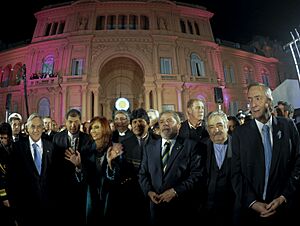
In November 2010, UNASUR countries signed an agreement to protect democracy. This agreement stated that member states would not accept challenges to their governments. If a country's democratic order was threatened, UNASUR could take action. This included suspending the country from the group or limiting trade and travel.
Free Movement of People
Citizens of UNASUR countries can visit other member states for up to 90 days using only their identification document. In November 2006, many countries agreed to remove visa requirements for tourists.
The Mercosur group, along with its associate members, created an "area of free residence with the right to work." This means citizens can live and work in other member countries more easily. They can get a temporary residence visa for up to two years. This can become permanent if they show they have a legal way to live.
Member Countries
| Signed In force Document |
1969 1969 Cartagena Agreement |
1991 1991 Treaty of Asunción |
2004 2004 Cusco Declaration |
2008 2011 Constitutive Treaty |
||||||||
| Union of South American Nations (UNASUR) | ||||||||||||
| Andean Pact (Andean Community of Nations) | ||||||||||||
| Mercosur | ||||||||||||
The countries that are part of UNASUR include:
- Bolivia (also part of the Andean Community)
- Venezuela (also part of Mercosur)
- Guyana
- Suriname
Some countries are also associate members of other groups like Mercosur or the Andean Community.
-
Member states of the Andean Community trade bloc.
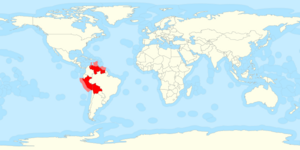
Territories Included
Some territories outside mainland South America are part of UNASUR because they belong to member states. For example, Isla Aves, a Venezuelan territory in the Antilles, is included.
Territories Not Included
Some parts of South America are not part of UNASUR. This is because they are territories of non-South American countries. These include:
- Aruba, Bonaire, and Curaçao (parts of the Kingdom of the Netherlands).
- French Guiana (an overseas department of France and part of the European Union).
- The Falkland Islands and South Georgia and the South Sandwich Islands (overseas territories of the United Kingdom).
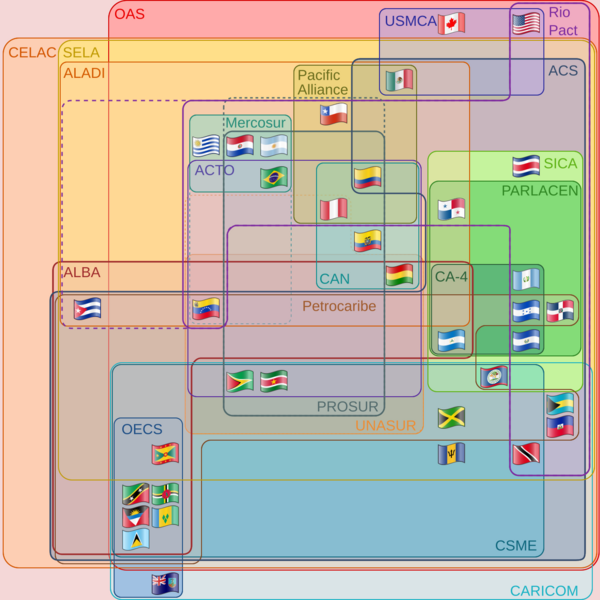
Related Organizations
- Pacific Alliance
- Mercosur
- Andean Community of Nations
- Community of Latin American and Caribbean States
- European Union
- African Union
- PROSUL/PROSUR
See also
 In Spanish: Unión de Naciones Suramericanas para niños
In Spanish: Unión de Naciones Suramericanas para niños



